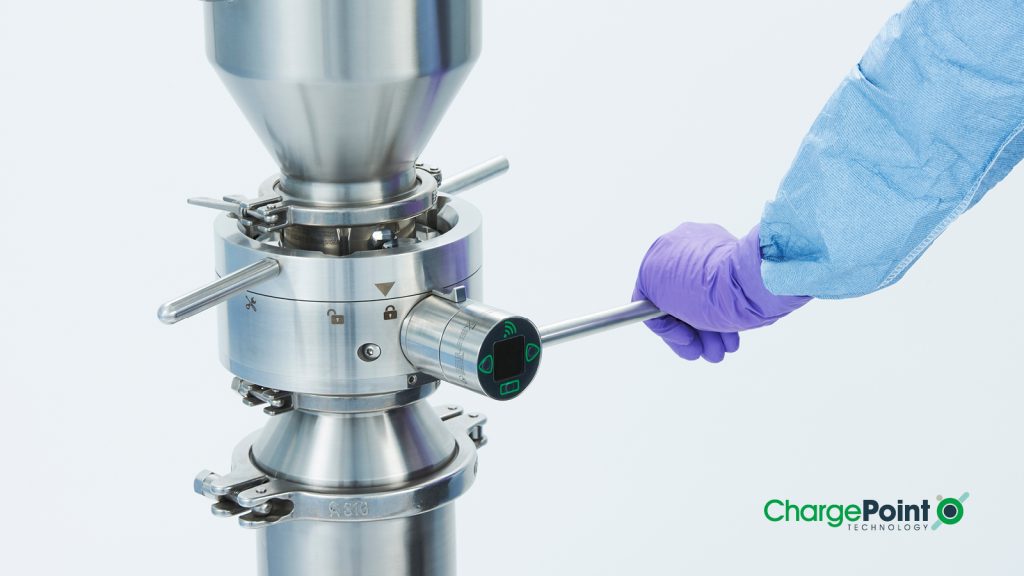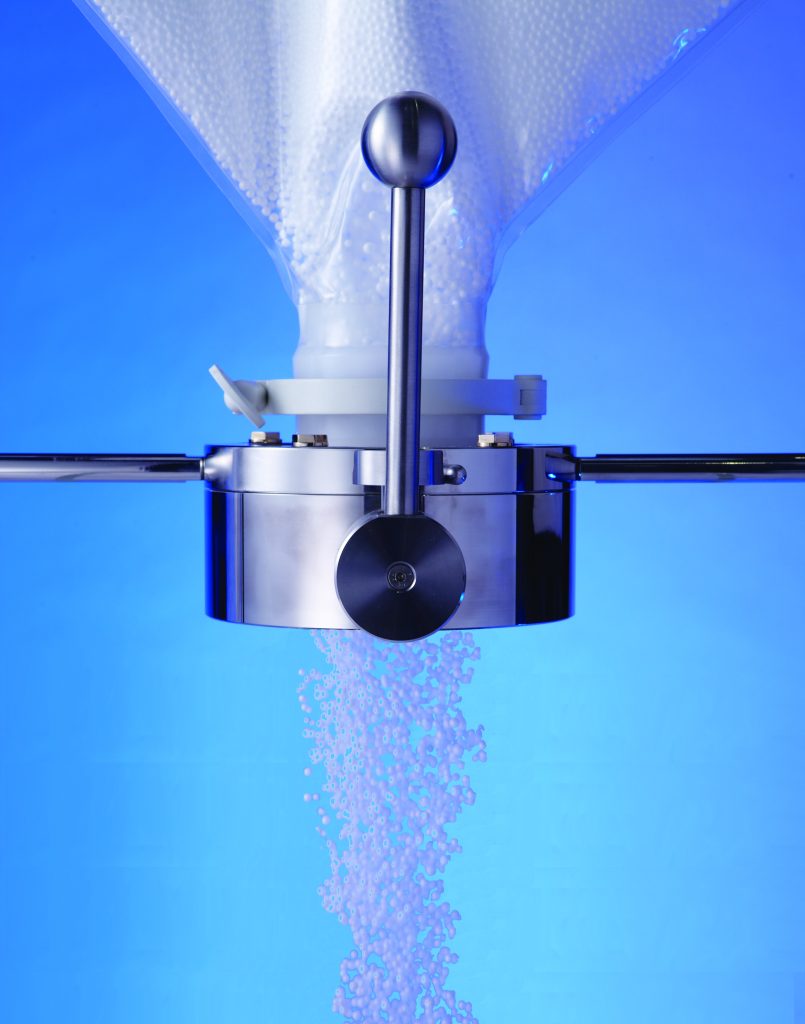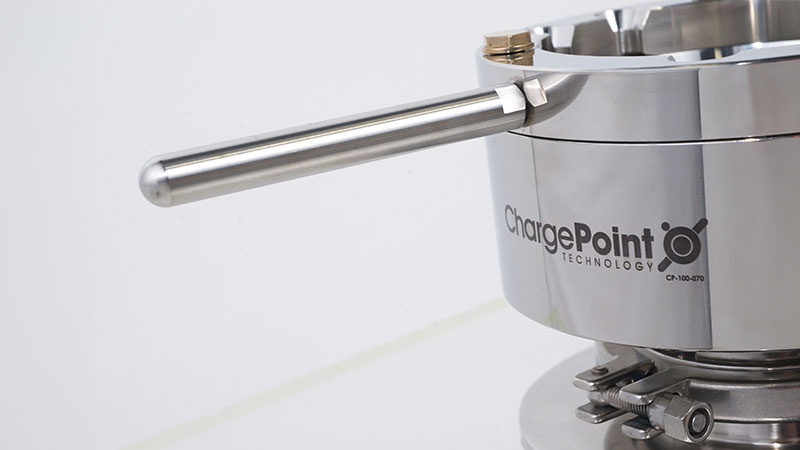In this article, Ben Wylie, Head of Product Management at ChargePoint Technology, discusses the hazards facing a range of industries when it comes to powder containment and worker safety, the limitations of existing measures to prevent them, and the steps companies can take to overcome them.
By Ben Wylie, Head of Product Management, ChargePoint
From pharmaceuticals to the chemical industries, the handling of toxic and potent powders poses a pressing challenge for manufacturers when it comes to ensuring safety. The consequences of improperly handling such materials can be severe, not only compromising the quality of the end product but also jeopardising the health and safety of workers, the environment and the local community. With these risks in mind, manufacturers must implement strict processes and harness specialised equipment to ensure the safety and containment of their powder transfers.
As industries evolve and expand their capabilities, organisations within them must strive to streamline their processes to ensure this safety. Manufacturers must also ensure cleanliness within handling environments, preventing potential leakages, and reducing waste generated during handling processes. However, these challenges are also driving the innovation of effective containment solutions and evolving technologies — streamlining powder handling processes and helping manufacturers meet strict containment demands.

The challenges of powder containment and worker safety across different industries
On average, up to 75% of manufacturing processes across all chemical industries involve particulate solids or powders at least once or twice throughout the cycle.¹
Such a high prevalence of these materials highlights the crucial need for manufacturers to prioritise effective containment measures, not only for powders but also for substances that retain their toxicity or potency regardless of their state. Even substances with typically inert properties in their consolidated state may become hazardous when transformed into a powder form, underscoring the importance of stringent safety protocols to mitigate risks associated with both powdered and inherently toxic materials.
In addition to ensuring safety, companies must implement powder containment to ensure the preservation of their valuable resources. It serves as a robust defence against a variety of hazards associated with powder handling, ranging from toxic inhalation and dermal exposure to combustibility and the risk of explosion.
The risks and challenges differ across each industry, but some of the most prominent that deal with regular powder handling include:
-
The pharmaceutical industry

Driven by ever-evolving innovations in drug development, the pharmaceutical industry has witnessed a surge in demand for highly potent active pharmaceutical ingredients (HPAPIs) in recent years. Estimated at EUR 23.42 billion in 2022, the HPAPI market is expected to grow at a compound annual growth rate of 6.2% from 2023 to 2030.²
These compounds offer potent therapeutic effects at low doses but require stringent containment due to their potential to cause various adverse health effects in operators who are exposed to them. Pharmaceutical manufacturers must adhere to strict regulatory standards, including those laid out in good manufacturing practice (GMP) guidelines.³ These outline the minimum standards and legislation to ensure proper containment.
To protect personnel and streamline processes, manufacturers must adopt flexible and cost-effective solutions to contain their drug powder materials. Closed powder handling systems are a critical necessity in pharmaceutical manufacturing due to the high potency and reactivity of these substances.
-
The battery industry
Driven by favourable shifts in attitude towards electric vehicles and other alternatives to using fossil fuel sources amid the climate and energy crises, there has been a global surge in demand for energy storage solutions. In fact, by 2030, global battery demand could reach nine terawatt-hours (TWh) annually, 15 times the levels seen in 2021.⁴
The battery industry relies heavily on highly sensitive raw materials such as cobalt, nickel and manganese, as well as various cathode materials such as lithium-ion manganese oxide (LMO), lithium cobalt oxide (LCO) and lithium nickel manganese cobalt (NMC) oxides. These materials are vulnerable to temperature changes and contaminants, and may possess pyrophoric properties, necessitating meticulous handling and precautions by manufacturers. Due to these risks, battery manufacturers must adhere to regulations such as the U.S. Occupational Safety and Health Administration (OSHA) regulations that address the handling of hazardous materials.⁵
-
The nutritional foods industry
Providing sustenance to often vulnerable populations with weakened immune systems, such as cancer patients, the nutritional foods industry is under high scrutiny to adhere to uncompromised food standards.
Containment risks are a crucial area of concern during food processing as manufacturers must strive to eliminate the potential for contamination. They must also adhere to strict regulations, including U.S. Food and Drug Administration (FDA) guidelines on handling food products and their containment.⁶
-
The nuclear industry
Nuclear manufacturers are held to strict regulatory requirements when handling materials such as uranium, plutonium, coolants, mixed oxide fuels and radioactive waste. These include the US Nuclear Regulatory Commission (NRC) guidelines⁷ as well as international standards set out by the International Atomic Energy Agency (IAEA).⁸ During the transfer of these materials across various processes, manufacturers must ensure airtight containment to prevent radioactive exposure. Failure to contain these materials poses enormous risks beyond individual worker safety – also impacting wider public health and the environment – making it of critical importance to ensure their proper handling.
What are the existing containment solutions?
Although there are several methods of containment available to these manufacturers, each comes with its own set of limitations. These include:
-
Vacuum powder transfer
Implemented in manufacturing scenarios where gravity alone cannot facilitate the movement of powder materials, vacuum transfers can be employed across a wide range of processes. These include the handling of raw materials, charging or discharging process equipment and packaging the finished product.
By creating a pressure differential, vacuum transfer methods create a force that guides powders along their path from one production line to another, even when elevation changes occur. This technique serves as a controlled nudge, coaxing powders to transition seamlessly from one area to another.
Although this method is effective at minimising containment risks in challenging environments, such as those where the gravitational flow is not enough (i.e., through intricate piping systems or movement through low to high levels), it may not be suitable for all powder transfer processes.
-
Cone valves
Cone valves are particularly useful for controlling the discharge of powders from containers, silos, and other storage vessels. Their design features a conical-shaped rotor positioned within a cylindrical housing, where the cone can be rotated to control the opening and closing of the valve. This gives operators greater precision control over the flow rate, proving particularly beneficial for applications where accurate dosing and controlled material flow are critical.
How can manufacturers solve the containment conundrum?
When handling and transferring potent powder materials – whether they are destined for immediate processing or storage for future use – manufacturers must exercise utmost caution to prevent contamination across transfer processes. Although there are limitations to existing solutions, there are others that can be used in conjunction with or as standalone components to enhance this process. These include the split butterfly valve (SBV) – a system comprising two key components:
- An active half used to establish a connection with production line equipment.
- A passive half used to attach to the mobile container.
Once combined, these halves act as a secure conduit, facilitating the closed powder transfer that, once connected, enables the powder to flow without direct contact with the surrounding environment or operators.

Designed with GMP manufacturing environments in mind, these components are easy to clean and sterilise between uses. With their compact size and ease of disassembly and reassembly, they are also suitable for applications where space may be limited.
Although SBV systems can be employed as the standalone contained transfer methodology in conjunction with small rigid bottles, disposable bags, or larger intermediate bulk containers, they can also easily be incorporated alongside vacuum transfers. By working together, these systems provide a secure and airtight connection between the vacuum system and the processing equipment or containers.
SBVs can also be paired with cone valves for powder transfer, acting as the filling connection point between the processing equipment and intermediate container where a low-profile space-saving installation is more critical. The cone valve is best suited to the discharge (emptying) connection of the intermediate container to help regulate the flow of powder.
Harnessing the benefits of single-use technologies
To further streamline transfer processes, manufacturers are turning to single-use (SU) variants of SBVs for their efficiency benefits. These components are designed to be disposed of, reducing the labour-intensive cleaning and validation processes required of their non-SU counterparts.
By eliminating the requirement to clean these components, manufacturers can significantly reduce the risk of contamination between transfers. Ultimately, components such as SU SBVs help manufacturers ensure proper containment throughout their powder transfer processes while also remaining compliant with strict industry regulations.
What does the future of powder transfer look like?
Innovative advancements in valve technologies will continue to adapt to meet the demand for intricate powder-handling solutions across all industries. Manufacturers must stay at the forefront of these advancements, taking care to select the right valves and combined solutions to bring unparalleled control over powder transfers and ensure containment at every stage.
Ultimately, by working with experts in powder containment, manufacturers can future-proof their transfer and containment processes. With the right guidance for each project, manufacturers can ensure uncompromised containment while streamlining processes, heightening worker safety, and protecting the surrounding environment and communities they work in.
About the author
 Ben Wylie is the Head of Product Management at ChargePoint. He joined ChargePoint in 2005 and is responsible for the day-to-day and strategic management of the product portfolio, including the development of the ChargePoint single use solutions. Ben has 15 years of experience in Pharma with a focus on marketing and product management of powder processing and containment handling.
Ben Wylie is the Head of Product Management at ChargePoint. He joined ChargePoint in 2005 and is responsible for the day-to-day and strategic management of the product portfolio, including the development of the ChargePoint single use solutions. Ben has 15 years of experience in Pharma with a focus on marketing and product management of powder processing and containment handling.
References
1 https://www.sciencedirect.com/science/article/pii/S2405844023037052
2 https://www.grandviewresearch.com/industry-analysis/high-potency-active-pharmaceutical-ingredients-hpapi-market
3 https://www.who.int/teams/health-product-and-policy-standards/standards-and-specifications/gmp
4 https://batteriesnews.com/global-battery-demand-surge-2030-supply/
5 https://www.osha.gov/battery-manufacturing/hazards
6 https://www.accessdata.fda.gov/scripts/cdrh/cfdocs/cfcfr/CFRSearch.cfm?fr=101.17
7 https://www.nrc.gov/reading-rm/doc-collections/cfr/index.html
8 https://www-pub.iaea.org/MTCD/Publications/PDF/P1856_web.pdf
About this Featured Story
This Featured Story is an article from our Valve World Magazine, October 2023 issue. To read other featured stories and many more articles, subscribe to our print magazine. Available in both print and digital formats. DIGITAL MAGAZINE SUBSCRIPTIONS ARE NOW FREE.
“Every week we share a new Featured Story with our Valve World community. Join us and let’s share your Featured Story on Valve World online and in print.”


